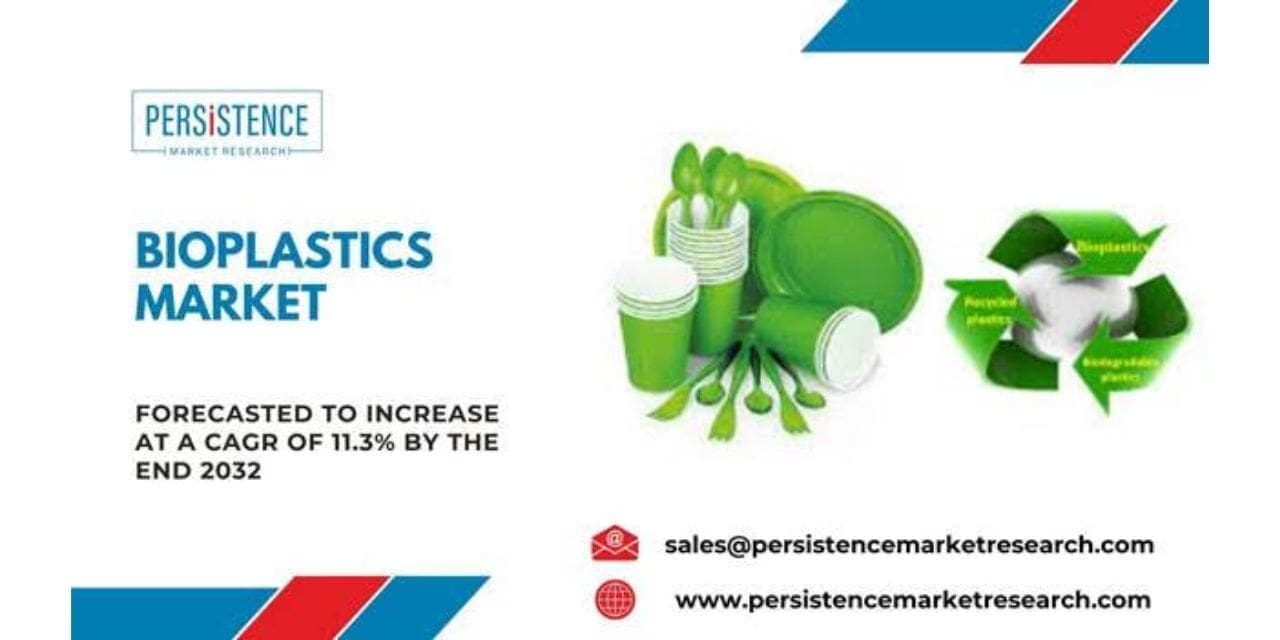In the face of growing environmental concerns and a push for sustainable practices, the global plastics industry is undergoing a transformative shift. Traditional plastics, derived primarily from fossil fuels, have long been a major contributor to pollution and environmental degradation. However, as the world becomes more environmentally conscious, the demand for sustainable alternatives has given rise to the bioplastics market. This burgeoning industry represents a significant stride towards greener, eco-friendlier solutions in packaging, consumer goods, and various other applications.
Persistence Market Research estimates the global bioplastics market at US$ 8.98 Billion for 2022. Sales of bio-based plastics are expected to increase at a CAGR of 11.3% and top a market valuation of US$ 26.2 Billion by the end of 2032. Demand for bio-based plastics is predominantly influenced by sustainability development, macroeconomic trends, and a strong focus on innovation.
Understanding Bioplastics:
Bioplastics, unlike conventional plastics, are derived from renewable resources such as corn starch, sugarcane, or even algae. They can also be produced through the fermentation of microorganisms. The key advantage of bioplastics lies in their ability to decompose naturally, reducing the burden on landfills and oceans. Bioplastics are categorized into various types, including bio-based, biodegradable, and compostable, each offering unique advantages depending on the intended application.
Market Dynamics:
The global bioplastics market has witnessed a remarkable surge in recent years, driven by a confluence of factors. Government initiatives promoting sustainable practices, consumer awareness about environmental issues, and corporate sustainability goals have collectively propelled the demand for bioplastics. The market is expected to continue its upward trajectory, reaching new heights in the coming years.
Environmental Concerns Drive Adoption: The adverse environmental impacts of traditional plastics, particularly single-use plastics, have triggered a heightened sense of urgency to find alternatives. Bioplastics, with their reduced carbon footprint and potential for biodegradability, have become a viable solution. Consumers are increasingly seeking eco-friendly options, and businesses are responding by incorporating bioplastics into their product lines.
Regulatory Support and Policies: Governments worldwide are introducing stringent regulations aimed at reducing plastic waste and promoting sustainable alternatives. Incentives, tax breaks, and subsidies for businesses adopting eco-friendly practices, including the use of bioplastics, have become commonplace. These regulatory measures play a pivotal role in steering the plastics industry towards a more sustainable future.
Technological Advancements: Continuous research and development in the field of bioplastics have led to significant advancements in terms of durability, versatility, and cost-effectiveness. Innovations such as bio-based PET (polyethylene terephthalate) and PLA (polylactic acid) have expanded the application scope of bioplastics, making them more attractive to industries traditionally reliant on conventional plastics.
Applications of Bioplastics:
Bioplastics have found applications in a diverse range of industries, showcasing their versatility and adaptability. Some notable applications include:
Packaging Industry: The packaging sector has emerged as a major consumer of bioplastics. With consumers demanding sustainable packaging solutions, bioplastics offer a viable alternative to traditional plastic packaging. From food containers to bags and bottles, bioplastics are making significant inroads in reducing the environmental impact of packaging materials.
Automotive Sector: The automotive industry is increasingly incorporating bioplastics into various components, including interior panels, upholstery, and even structural parts. As the automotive sector prioritizes sustainability, bioplastics contribute to lighter and more eco-friendly vehicles.
Consumer Goods: Bioplastics are gaining popularity in the production of consumer goods such as disposable cutlery, plates, and cups. The inherent biodegradability of certain bioplastics ensures that these products have a minimal impact on the environment, particularly in single-use applications.
Challenges and Opportunities:
While the bioplastics market shows immense promise, it is not without its challenges. Some of the key obstacles include:
Cost Considerations: The production of bioplastics can be more expensive than traditional plastics, primarily due to the costs associated with sourcing and processing renewable feedstocks. However, ongoing research and technological advancements aim to address this challenge, making bioplastics more cost-competitive in the long run.
Infrastructure and Recycling: The existing infrastructure for plastic recycling is not entirely compatible with bioplastics. As a result, proper disposal and recycling facilities for bioplastics need to be developed. Additionally, educating consumers on the correct disposal methods is crucial to maximize the environmental benefits of bioplastics.
Competition with Conventional Plastics: The plastics industry has been deeply entrenched in the use of conventional plastics for decades. Overcoming the inertia of established practices and convincing industries to make the switch to bioplastics presents a significant challenge. However, the rising tide of environmental consciousness is gradually shifting this mindset.
The Future Outlook:
The bioplastics market is poised for substantial growth in the coming years, driven by a combination of consumer demand, regulatory support, and technological advancements. Several trends and developments indicate a promising future for the industry:
Research and Innovation: Ongoing research and development are expected to yield breakthroughs in bioplastics technology. This includes the development of new bio-based polymers, enhanced biodegradability, and improved performance characteristics, further expanding the scope of applications.
Collaborations and Partnerships: Collaboration between government bodies, private enterprises, and research institutions is crucial for the widespread adoption of bioplastics. Partnerships can drive innovation, reduce costs, and create a more conducive environment for the integration of bioplastics into mainstream industries.
Consumer Education: Increasing awareness among consumers about the environmental benefits of bioplastics is vital. Educating the public on proper disposal practices and the advantages of choosing products made from bioplastics will contribute to the continued growth of the market.
As the global plastics industry undergoes a paradigm shift towards sustainability, the bioplastics market is emerging as a key player in this transformation. The increasing demand for eco-friendly alternatives, coupled with regulatory support and technological advancements, positions bioplastics as a viable and essential component of the future of plastics. While challenges persist, the momentum towards a more sustainable and environmentally conscious plastics industry is undeniable, heralding a new era where bioplastics take center stage.

